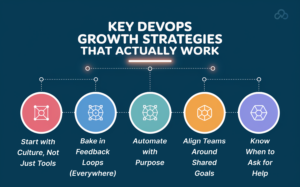DevOps in Business: What It Is, Why It Matters, and How to Get It Right

Let’s be honest, Business DevOps used to be that thing the backend folks talked about while the rest of the company zoned out. Maybe it popped up in a Jira comment, maybe someone mumbled about pipelines during sprint planning, and that was it. If you weren’t knee-deep in code or managing servers, you probably didn’t care. And honestly? That used to be fine.
But yeah… things changed.
Business DevOps isn’t just a tech-side upgrade anymore. It’s quietly made its way into how whole companies run, how fast they move, how they recover from messes, and even how they plan product roadmaps. These days, it’s not just some ops thing tucked away in the background. It’s front and center. And whether teams admit it or not, it’s becoming the difference between staying ahead… or falling flat.
Now, here’s where people get it twisted: DevOps isn’t just flashy tools, colorful dashboards, or chasing the next deploy script. That’s surface stuff. Underneath, it’s about how people work together. It’s about fixing the messy parts, communication gaps, clunky handoffs, weird silos. It’s about making stuff ship without feeling like everything’s about to break. Or, okay, at least breaking less.
So if you’re running a company, managing a team, or even just trying to stop your workflows from turning into recurring nightmares, this is worth paying attention to. Whether you’re thinking about trying DevOps managed services, hiring a DevOps consultant, or just trying to survive your next deployment without a mini-meltdown, this guide’s here to make sense of it all.
What Is Business DevOps, Exactly?
Alright, let’s not overcomplicate it. Business DevOps isn’t just DevOps in a corporate outfit. And no, it’s not some buzzword someone slapped onto a PowerPoint to impress the boardroom. It’s… more than that.
At its core, it’s DevOps thinking applied beyond the dev team. Like, way beyond. It’s not just CI/CD pipelines or faster releases anymore, it’s about making the whole business work together like it’s actually one team (shocking, right?).
Instead of just asking, “How fast can we ship this?” Business DevOps asks, “Why are we shipping it in the first place?” It pulls the focus back to outcomes, things that matter to real people, not just ticket closures and sprint burndowns.
And yeah, it shines a pretty bright light on those awkward gaps between teams. You’ve seen it: product wants X, engineering heard Y, and execs are pitching Z to investors. That misalignment? It’s what turns a good roadmap into a pile of delays and finger-pointing. Business DevOps steps in and says, “Hey, maybe we should all be pulling in the same direction?” Sometimes that means bringing in a DevOps consultant, someone who’s been through the mess and knows how to untangle it. Other times, it’s leaning on DevOps managed services to offload the noisy, repetitive stuff so your team can breathe again and actually focus.
Bottom line? This isn’t just about automation or tooling. It’s about building a business that learns faster, adapts quicker, and doesn’t melt down every time something changes. So if you’ve been treating DevOps like it belongs in the server room… might be time to let it out and let it lead.
The Business Value of DevOps
Alright, let’s break this down, why should anyone outside the dev team even care about DevOps? I mean seriously, what does any of this have to do with business growth, strategy, or, you know, actually making money?
Business DevOps isn’t just about making developers happy or shipping code a little faster (though, hey, that’s nice too). It’s about creating momentum, real momentum, that moves across the entire company. Because when your technical teams are in sync with your business goals? That’s when things start clicking.
Take speed, for example. Yeah, getting features out faster is great. You test sooner, respond quicker, and meet user needs before your competitors even finish their roadmap. Especially now, when markets shift fast and attention spans are shorter than ever, that kind of agility isn’t just useful, it’s survival.
Here’s where DevOps really shines: it brings order to the chaos. When engineering, ops, QA, and product teams are actually working together, like, really communicating, not just tossing tickets over the fence, you get smoother handoffs, fewer dropped balls, and way less of that classic “Wait, who was supposed to fix this?” moment.
Also, with tighter feedback loops, you stop building in the dark. You learn as you go. That means fewer bad surprises, better decisions, and products that improve every single week, not just at the end of the quarter when someone finally checks the metrics.
And look, we can’t ignore reliability. Users don’t care how fast your team is moving if your app crashes every Friday night. But with solid DevOps practices, like continuous testing, observability, automation, you get the speed and the stability. That combo? That’s what builds trust with customers.
Key DevOps Growth Strategies That Actually Work
Not every Business DevOps approach leads to meaningful growth. Some sound good in theory but fall apart once they hit real teams, real deadlines, and real user demands. So, what actually works?

Start with Culture, Not Just Tools
Let’s be honest, tools are the easy part. Anyone can install Jenkins or hook up a CI/CD pipeline. But culture? That’s tougher. If your teams don’t trust each other, if blame gets thrown around every time something breaks, your fancy toolchain won’t matter much. Real DevOps success starts with shared ownership, open communication, and a mindset that treats failures as learning, not finger-pointing.
Bake in Feedback Loops (Everywhere)
Feedback isn’t just something that happens after launch. It should be woven into everything, from code commits to customer interactions. The faster you learn what’s working and what’s not, the quicker you improve. That means automated tests, monitoring dashboards, retros, and even casual team check-ins. All of it matters.
Automate with Purpose
Automation is powerful, but only if you’re using it to solve real problems. Don’t automate for the sake of it. Instead, target the stuff that’s slowing your team down or causing errors. For example: repetitive deployments, flaky staging environments, manual test runs. Each one you automate frees up time and reduces stress.
Align Teams Around Shared Goals
DevOps isn’t just dev and ops, it’s product, QA, support, leadership… everyone. When priorities aren’t aligned, you get chaos. Think endless rework, missed handoffs, and features no one asked for. The fix? Shared KPIs, regular syncs, and a process that encourages collaboration, not silos.
Know When to Ask for Help
If your current setup isn’t cutting it, or if growth is happening faster than your team can handle, don’t be afraid to bring in outside support. DevOps consulting services and managed DevOps providers can give you the strategy, structure, and extra hands you need, without burning out your internal team.
DevOps Managed Services: When and Why to Consider Them
Alright, let’s talk about something a lot of companies ignore until it’s, well, too late.
You’ve got this ambitious roadmap. Maybe a lean team. Maybe a mountain of tech debt. And you’re trying to grow fast while keeping systems from catching fire. But here’s the thing: doing everything in-house? Not always the smartest move.
That’s where DevOps managed services come in.
So, what are they, exactly?
Think of them as your off-site DevOps crew. They’re not just consultants who give you a one-time playbook and bounce. They actually roll up their sleeves and handle stuff, setting up infrastructure, managing pipelines, automating releases, monitoring everything, you name it.
And yeah, they usually bring their own tools and frameworks, which, honestly, can save you months of trial and error.
But wait, isn’t outsourcing risky?
Totally fair question. And sure, if you just pick the cheapest provider or don’t vet them properly, yeah, it can backfire. But good managed services? They embed with your team, ask questions, and figure out where things are fragile and quietly start fixing it without causing more chaos.
Plus, you’re not giving up control. You’re gaining capacity. Instead of stretching your devs thin trying to maintain Jenkins or troubleshoot broken cloud config, they can, I dunno… build things. Which is kind of what you hired them for.
When should you bring one in?
Honestly? Sooner than most teams think. If your deployments feel risky, if monitoring is half-broken, or if you’re waking up to alerts more than once a week, it’s probably time. Also, if you’re scaling quickly and hiring can’t keep up, managed services can fill the gap without the overhead of a full-time hire.
In the long run, it’s not just about moving faster, it’s about moving smarter. DevOps managed services help you skip the painful parts of growing pains and focus on the stuff that actually grows the business.
So yeah, sometimes the best Business DevOps decision isn’t doing more yourself. It’s knowing when to call in backup.
Choosing the Right DevOps Consulting Services
Let’s be real, there’s no shortage of companies claiming they “do DevOps.” But not all DevOps consulting services are created equal.
So how do you choose the right one?
Well, first off, don’t just go for the biggest name or flashiest pitch. Look for teams that take time to understand your business, not just your infrastructure. A good DevOps consultant will ask questions, dig into your workflows, and uncover what’s slowing you down before offering solutions.
Also, pay attention to how they communicate. If they can’t explain complex systems in plain language, working with them long-term might be a headache. And lastly, check for proof. Real case studies, past results, client feedback, the boring stuff that actually tells you whether they can deliver.
At the end of the day, the right partner isn’t just one who knows the tools, it’s the one who knows how to make them work for you.
DevOps and Long-Term Business Growth
Let’s be honest, DevOps isn’t some quick-fix bandage you slap on and hope for the best. Sure, it can speed things up right away, and yeah, that’s great. But the real magic? It shows up over time.
In the beginning, most teams get by just fine without it. You ship quickly, maybe skip a few best practices, and somehow, everything holds together, barely. But as soon as your product starts picking up steam, that’s when cracks show. The team grows, the codebase turns into spaghetti, and all those rushed decisions from earlier? They come back to bite. Hard.
That’s exactly where a proper Business DevOps mindset starts pulling its weight.
Instead of just checking boxes and sprinting from task to task, your team builds systems that actually scale. You’ve got pipelines catching bugs before they hit production, automated processes that keep things moving, and workflows that don’t require 1 a.m. heroics to stay afloat.
And over time? That foundation changes everything.
Now, suddenly your business becomes more flexible. You can respond to customer feedback faster. You can experiment without sweating every edge case. And, honestly, people stop burning out. Because firefighting every week? That’s not sustainable. But having reliable systems that do the heavy lifting? That’s how teams stay healthy and productive.
No, DevOps won’t turn your business into a unicorn overnight. But it will keep you from crumbling under your own growth. Whether you’re spinning up new teams, expanding globally, or just trying to manage more users without the whole thing collapsing, DevOps gives you the structure to handle it.
It’s not flashy. It’s not hype. But if you’re playing the long game, it’s the smartest move you can make.
DevOps Is a Business Strategy, Not Just a Tech Trend

DevOps isn’t some magic wand you wave and boom, all your problems disappear. It’s not going to fix bad communication, broken processes, or unclear goals overnight. But if you treat it like what it actually is, a long-term shift in how your business works, then yeah, that’s when the pieces finally start to fall into place.
Because here’s the thing: DevOps isn’t just about pushing code or spinning up servers. It’s about the bigger picture, how your business delivers value, deals with stress, and adapts when (not if) things go sideways. And in today’s world, if your delivery process can’t keep up with your ambition? That’s a problem.
That’s also why so many companies are leaning into it now. They’re reaching out to DevOps consultants, signing on for managed services, and actually putting in the work to make their teams stronger and more aligned. Not just to move faster, but to move smarter. And to stop waking up at 3 a.m. because something broke. Again.
So no, this isn’t just another tech trend you can ignore until it goes away. It’s a full-on shift in how modern businesses operate. It changes your speed, your stability, and honestly, your sanity.
Start small. Start where you are. But start. Because the sooner you build DevOps into your foundation, the easier everything else becomes.
Do you like to read more educational content? Read our blogs at Cloudastra Technologies or contact us for business enquiry at Cloudastra Contact Us